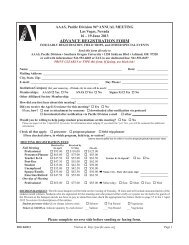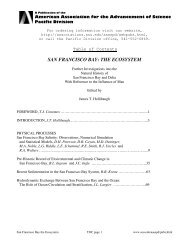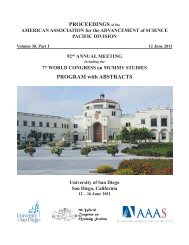Vol 31, Part I - forums.sou.edu ⢠Index page - Southern Oregon ...
Vol 31, Part I - forums.sou.edu ⢠Index page - Southern Oregon ...
Vol 31, Part I - forums.sou.edu ⢠Index page - Southern Oregon ...
You also want an ePaper? Increase the reach of your titles
YUMPU automatically turns print PDFs into web optimized ePapers that Google loves.
ABSTRACTS – Symposia<br />
in cellulose. Atomistic studies include Quantum Chemical<br />
calculations, Replica Exchange Molecular Dynamics (MD)<br />
and conventional MD simulations. Coarse-grained studies<br />
include statistical mechanical and phenomenological models.<br />
Importantly, our computations provide useful clues on<br />
rational proc<strong>edu</strong>re for the efficient degradation of cellulose.<br />
48 Computer Simulation of Lignocellulosic Biomass, LOU-<br />
KAS PETRIDIS (Oak Ridge National Laboratory, 1 Bethel<br />
Valley Rd, Oak Ridge TN 37919; petridisl@ornl.gov).<br />
The temperature-dependent structure and dynamics of<br />
individual softwood lignin polymers in aqueous solution<br />
have been examined using extensive molecular dynamics<br />
simulations. With decreasing temperature the lignins are<br />
found to transition from mobile, extended to glassy, compact<br />
states. The low-temperature collapse is thermodynamically<br />
driven by the increase of the translational entropy and density<br />
fluctuations of water molecules removed from the hydration<br />
shell, thus distinguishing lignin collapse from enthalpically<br />
driven coil-globule polymer transitions and providing a<br />
thermodynamic role of hydration water density fluctuations<br />
in driving hydrophobic polymer collapse. Lignin also forms<br />
aggregates in vivo and poses a barrier to cellulosic ethanol<br />
production. Neutron scattering experiments and molecular<br />
dynamics simulations reveal that lignin aggregates are<br />
characterized by a surface fractal dimension that is invariant<br />
under change of scale from 1-1000Å . The simulations<br />
also reveal extensive water penetration of the aggregates and<br />
heterogeneous chain dynamics corresponding to a rigid core<br />
with a fluid surface. Finally, the interaction of lignin with<br />
cellulose is examined and differential binding to crystalline<br />
and amorphous cellulose explained thermodynamically.<br />
49 Identification of Conserved Binding Motifs for Cellulase<br />
Enzymes and the Creation of a Novel Approach to Identifying<br />
the Enzymatic Mode of Action, SAMBASIVARAO<br />
V SOMISETTI (1613 Illinois Street, Golden, CO 80401;<br />
somissv@tigermail.auburn.<strong>edu</strong>).<br />
Docking calculations have been conducted between 30+<br />
cellulase enzymes and cellobiose to determine the various<br />
binding motifs and to create a model capable of predicting<br />
the enzymatic mode of action (i.e., endo-, exo-, or mixed<br />
endo-/exo-). It is found that the binding motifs between cellobiose<br />
and cellulase enzymes are highly conserved across<br />
species and between endocellulase and cellobiohydrolase<br />
(exocellulase CBHI and CBHII) enzymes. The various binding<br />
pose distributions have been classified into two dominant<br />
structural features, a single maximum pyramidal distribution<br />
that is indicative of cellobiohydrolase enzymes and a bimodal<br />
distribution indicative of endocellulase enzymes. The<br />
observed binding patterns are found to depend on a specific<br />
number of critical enzyme-substrate interactions that are<br />
highly conserved across species. Utilizing a coarse grained<br />
technique to systematically and unambiguously interpret the<br />
docking results has resulted in the ability to identify/predict<br />
the enzyme mode of action based on the cellobiose-cellulase<br />
binding poses. To gain further insights into the structural<br />
requirements that determine the enzymatic mode of action, a<br />
pattern recognition relationship (PRR) has been studied. The<br />
PRR correlation for exo-cellulases resulted in an r 2 value of<br />
0.96 showing good predictive performance with an adjusted<br />
r 2 value of 0.81. The identified conserved docking poses and<br />
the correlation of a PRR provide valuable insights into the<br />
structure function relationship in cellulase enzymes while<br />
also serving as a predictive tool for the implementation of<br />
structure-based intelligent design of endo- and exocellulase<br />
enzymes.<br />
50 Biomass to Biofuels: Computer Modeling of Cellulose<br />
and Cellulases, MICHAEL F CROWLEY 1 , GREGG<br />
T BECKHAM 2,3 , LINTAO BU 2 , and JAMES F MAT-<br />
THEWS 1 ( 1 Biosciences Center, National Renewable Energy<br />
Laboratory, 15013 Denver West Parkway, Golden, CO;<br />
2<br />
National Bioenergy Center, National Renewable Energy<br />
Laboratory, 15013 Denver West Parkway, Golden, CO;<br />
3<br />
Department of Chemical Engineering, Colorado School of<br />
Mines, Golden, CO; michael.crowley@nrel.gov).<br />
One of the important contributions to solving the<br />
world’s energy needs for the future will come from the sustainable<br />
use of biomass to produce fuels. These renewable<br />
fuels are immediately essential as fungible replacements for<br />
liquid transportation fuels but there is still much work that<br />
can be done to improve the economic viability of the industrial<br />
implementation. We will present our efforts to improve<br />
enzymatic conversion of cellulosic biomass to sugars, which<br />
can be easily converted to liquid fuels such as ethanol in<br />
the present and more advanced, higher energy dense fuels<br />
in the future. We present the computational modeling and<br />
analysis of cellulose structure and thermodynamics, cellulase<br />
structure and function, and cellulosome assembly and<br />
interaction with biomass in the form of plant cell walls. We<br />
use molecular dynamics simulations to extract the dynamical<br />
and thermodynamic properties of cellulose in multiple<br />
shapes and crystalline forms and its response to temperature<br />
changes that occur in biomass pretreatment. We show the<br />
dependence of the twisting behavior of cellulose on fiber<br />
diameter and explain the origin of the twist. We use thermodynamic<br />
sampling methods to determine the free energy<br />
of decrystallization, enzyme binding affinities, and product<br />
expulsion energies of both native and mutated cellulases.<br />
Our computer simulations inform the molecular biologists<br />
of possible improvements that can be made to enzymes and<br />
biomass for cheaper biofuels.<br />
61








